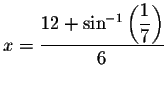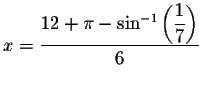
 SOLVING TRIGONOMETRIC EQUATIONS
SOLVING TRIGONOMETRIC EQUATIONS

Note: If you would like a review of trigonometry, click on trigonometry.
Example 3: Solve for x in the following equation.
There are an infinite number of solutions to this problem.
First isolate the sine term.

To solve for x, we have to isolate x. How do we isolate the x? We could take the inverse (arcsine) of both sides. However, inverse functions can only be applied to one-to-one functions and the sine function is not one-to-one.
Let's restrict the domain so the function is one-to-one on the restricted
domain while preserving the original range. The sine function is one-to-one
on the interval
![$\left[ -\displaystyle \displaystyle \frac{\pi }{2},\displaystyle \displaystyle \frac{\pi }{2}\right] .$](img3.gif) If we
restrict the domain of
If we
restrict the domain of
![]() to that interval , we can
take the arcsine of both sides of each equation to find the reference angle.
to that interval , we can
take the arcsine of both sides of each equation to find the reference angle.

The angle x is the reference angle. We know that

 ,
then
,
then


The period of ![]() equals
equals ![]() and the period of
and the period of
![]() equals
equals
![]() ,
this means other solutions exists
every
,
this means other solutions exists
every
![]() units. The exact solutions are
units. The exact solutions are

where n is an integer.
The approximate values of these solutions are

where n is an integer.
You can check each solution algebraically by substituting each solution in the original equation. If, after the substitution, the left side of the original equation equals the right side of the original equation, the solution is valid.
You can also check the solutions graphically by graphing the function formed by subtracting the right side of the original equation from the left side of the original equation. The solutions of the original equation are the x-intercepts of this graph.
Algebraic Check:
Check solution x=2.02389126
Left Side:
Right Side: ![]()
Since the left side of the original equation equals the right side of the original equation when you substitute 2.02389126 for x, then 2.02389126is a solution.
Check solution x=2.499707514
Left Side:
Right Side: ![]()
Since the left side of the original equation equals the right side of the original equation when you substitute 2.499707514 for x, then 2.499707514is a solution.
We have just verified algebraically that the exact solutions are
 and
and
 and these solutions repeat every
and these solutions repeat every
![]() units. The approximate values of these solutions are
units. The approximate values of these solutions are
![]() and
2.499707514 and these solutions repeat every
and
2.499707514 and these solutions repeat every
![]() units.
units.
Graphical Check:
Graph the equation
![]() (formed by
subtracting the right side of the original equation from the left side of
the original equation). Note that the graph crosses the x-axis many times
indicating many solutions. Let's check a few of these x-intercepts against
the solutions we derived.
(formed by
subtracting the right side of the original equation from the left side of
the original equation). Note that the graph crosses the x-axis many times
indicating many solutions. Let's check a few of these x-intercepts against
the solutions we derived.
Verify the graph crosses the x-axis at
2.02389126. Since the period is
 ,
you can verify that the graph also
crosses the x-axis again at
,
you can verify that the graph also
crosses the x-axis again at
![]() and at
<tex2htmlcommentmark>
2.02389126+1.04719755=3.0710888, etc.
and at
<tex2htmlcommentmark>
2.02389126+1.04719755=3.0710888, etc.
Verify the graph crosses the x-axis at
2.499707514. Since the period is
 ,
you can verify that the graph also
crosses the x-axis again at
,
you can verify that the graph also
crosses the x-axis again at
![]() and at
<tex2htmlcommentmark>
2.499707514+1.04719755=3.546905, etc.
and at
<tex2htmlcommentmark>
2.499707514+1.04719755=3.546905, etc.
Note: If the problem were to find the solutions in the interval
![]() ,
then you choose those solutions from the set of infinite
solutions that belong to the set
,
then you choose those solutions from the set of infinite
solutions that belong to the set
![]()
![]() ,
0.9766937,
1.45250999,
2.02389126,
2.4997075,
<tex2htmlcommentmark>
3.0710888, 3.546905,
4.11828636, 4.5941026, 5.1654839, 5.6413,
and
,
0.9766937,
1.45250999,
2.02389126,
2.4997075,
<tex2htmlcommentmark>
3.0710888, 3.546905,
4.11828636, 4.5941026, 5.1654839, 5.6413,
and
![]()
If you would like to test yourself by working some problems similar to this example, click on Problem.
If you would like to go to the next section, click on Next.
If you would like to go back to the equation table of contents, click on Contents.

